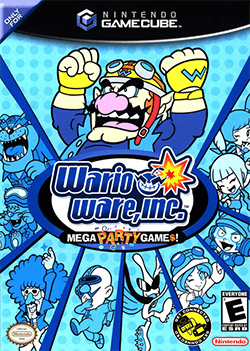 Our cooperative party game is inspired by the WarioWare series by Nintendo, specifically the Gamecube version WarioWare, Inc.: Mega Party Game$! released in April 2004 in North America.
Our cooperative party game is inspired by the WarioWare series by Nintendo, specifically the Gamecube version WarioWare, Inc.: Mega Party Game$! released in April 2004 in North America.
WarioWare is a funky, groovy, fast-paced, silly! game where players play “microgames.” Microgames are super short tiny games (<5 second duration) that require no real skill except reflexes and good eye sight. They are randomly chosen, give very little instruction, are quick to start, quick to end, and quick to move on to the next microgame. Microgames often call back to old Nintendo games or classics and utilize the player’s intuition to minimize the need for instructions. Microgames can be catch the baseball, pick the nose, have the monkey grab the banana, protect the flower, etc. Due to this nature, WarioWare is a game about games, a metagame. You can watch a gameplay of WarioWare microgames here.
WarioWare differentiates itself from other metagaming because it brought it to the mainstream and still lives on, being remade for new consoles every few years since its debut. It is the defining game for the metagaming genre! The whole concept and base mechanics of relying on series of randomized microgames subverts the idea and expectation for continuity that people come to expect of games. In WarioWare, the second you get a feel for the microgame, it is over and you are on to the next. These discontinuities prove continuity is not required to create coherent, playable, enjoyable games. Discontinuity brings its own special flavor fun as it inspires rule breaking, outside of the box thinking, and quick, not very well thought out action.
This specific WarioWare, Mega Party Game$!, is also special in its own accord because it is the first real instance of mainstream multiplayer metagaming. Players can choose different games/rulesets to play the microgames by. Players worked cooperatively to unlock new rulesets to play the microgames by. The rulesets either asked players to play cooperatively or competitively.
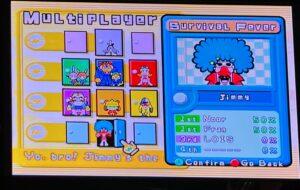
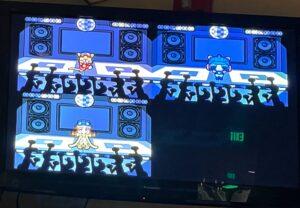
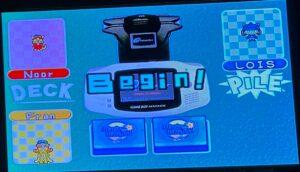
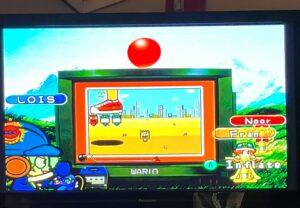
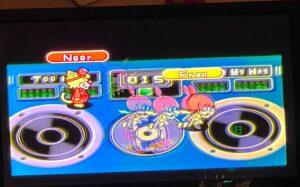
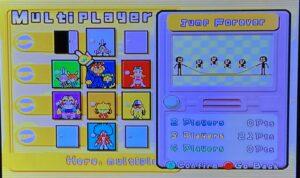
^The first image is the ruleset selection page in WarioWare (2004). The other five images are examples of WarioWare different rulesets – [1] win the dance battle by getting your microgame right each time the spotlight is on you, [2] win a pile of cards by playing a series of microgames on the cards, [3] inflate the balloon when it is not your turn and when it is your turn – get a microgame right quickly before the balloon pops!, and [4] each player plays 15 microgames in a row while the other players distract them on the screen. [5] Is an example of a cooperative jump roping game.
Some asked the players to interact with each other physically, like the “Doctor Says” ruleset. The player could be asked to “scream your favorite animal while playing this microgame!” and their competitors have to clap for them in the game. Whoever receives the most applause wins. Here, the group decides the winner instead of the game.
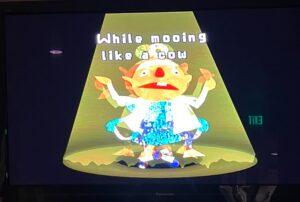


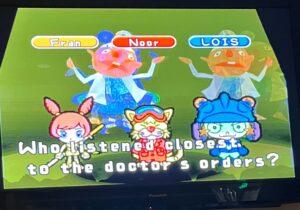
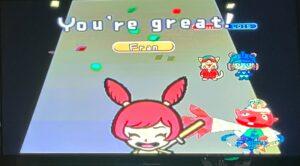
^Example of Doctor Says Ruleset
The game delivers a few kinds of fun with all those mechanics:
- Sensation – playing a series of random games is really exhilarating, the fast paced games also invoke excitement! There is lots of different sound effects and the controllers vibrate to really immerse the player into the experience.
- Submission – There is so much absurdity and silly microgames that one has to give in and relax in order to perceive enough to win each microgame. There is no time to read instructions so you have to surrender to the game. In the case of the “Doctor Says” game, you have to submit to being physically silly as well.
- Challenge – The fast pace and randomness aspect of the microgames is no joke! You really need to focus in order to get anywhere. As time passes, they become faster and could have visual obstructions to increase difficulty as well.
- Fellowship – All players come out bonded because they all are coming in with little to no experience and agree to be jerked around by the game together.
- Discovery – There are 213 microgame options and quite a few rulesets so the players have room to keep exploring and finding new microgames! Players were really excited by each new microgame they discovered and began to develop connections with different microgames.
When playing WarioWare, all players are paying attention and are really focused on the screen. People don’t pick up their phones or even really look away. This is probably due to the fast paced nature and having so many random microgame options that you can’t afford to look away and if you did, you might miss out on a microgame that you might have to play later. People felt frantic and were in a frenzy, and we found ourselves getting sillier as time passed due to the silliness of the game. The silliness factor is constantly represented in the graphic design, from the wonky buildings to the bold color palettes to the microgames themselves.

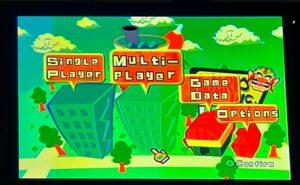

^Examples of WarioWare theme
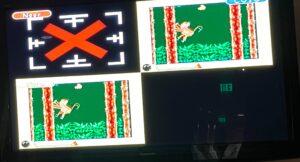
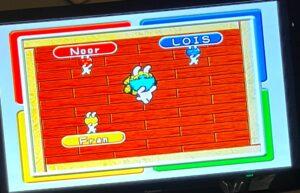
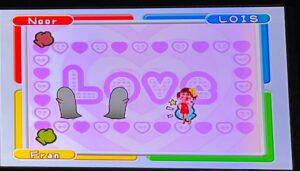
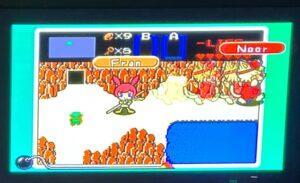


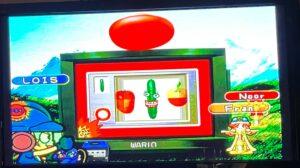
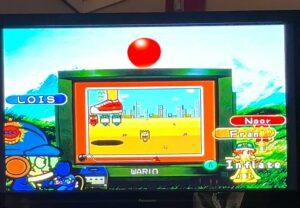

^Examples of WarioWare microgames – [1] group microgame where we all play at the same time in our screen, [2] and [3] group microgame where we are playing on the same screen, [4] individual microgame with opponent players walking on screen as visual impairment, [5-9] are individual microgame examples.
I really love WarioWare and there is not much I would do to make it better. It would be nice if there was a story line the multiplayer route could follow so the cooperativeness aspect could be better utilized. It would also be interesting if the game took stats on the multiplayer’s doing different rulesets as a whole and crown a best player overall to increase competitiveness. I really enjoy the subversions where players voted for each other to decide who wins and would also like to incorporate more in-person interaction as well. I can see how the microgames are really inaccessible, especially as poor eyesight is the most common disability in the United States and the microgames require such quick, detail action. It would expand the userbase if the users could adapt the set of microgames to be more accessible, such as increasing the time limit, excluding sound related microgames, or microgames that need the joystick.


